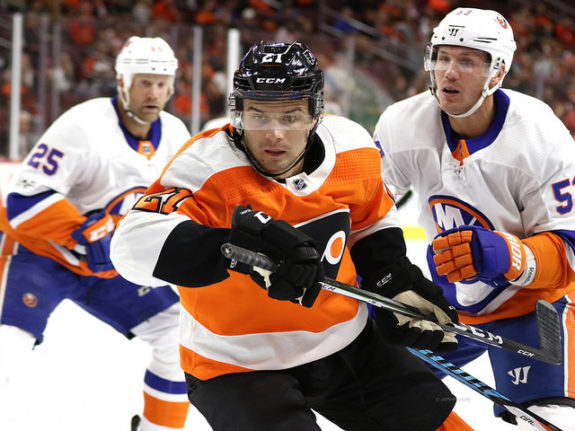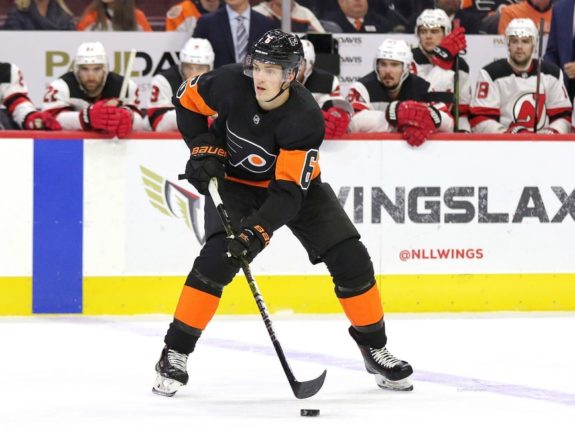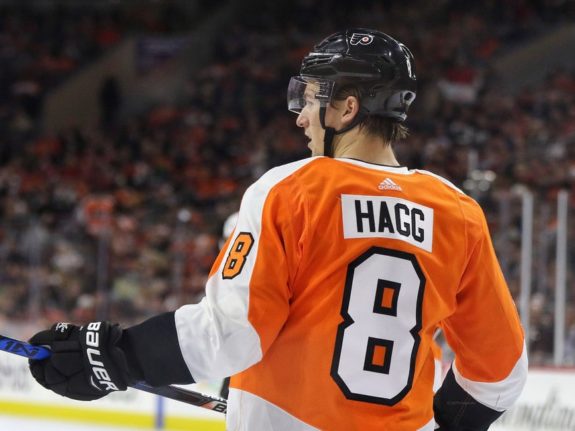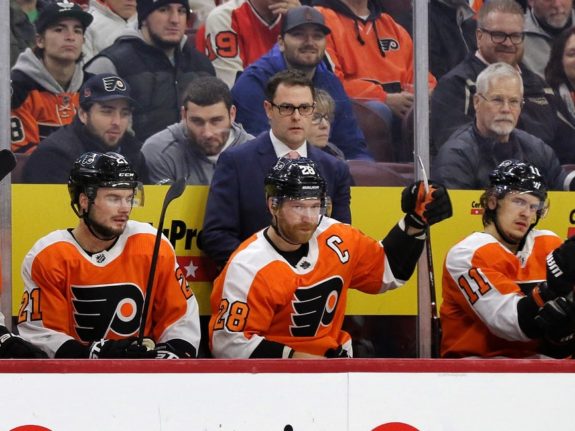Any coaching switch is going to result in on-ice changes. After 31 unsatisfying games, the Philadelphia Flyers fired head coach Dave Hakstol and replaced him with interim coach Scott Gordon, formerly of the team’s AHL Lehigh Valley Phantoms and, before that, of the New York Islanders.
Gordon’s had the team for 19 games, just long enough to start revealing player preferences. Some skaters have seen their roles expand under the new boss, while others have seen their opportunities diminish drastically. Here’s how the time-on-ice (TOI) situation has evolved for centers, wingers, and defensemen since the coaching change.
Nolan Patrick’s Ice Time a Victim of Depth
| CENTER | GP (Hakstol) | TOI (Hakstol) | GP (Gordon) | TOI (Gordon) | Change |
|---|---|---|---|---|---|
| Giroux | 31 | 20:36 | 19 | 21:59 | + 1:23 |
| Varone | 3 | 7:34 | 16 | 8:01 | + 0:27 |
| Couturier | 29 | 21:47 | 19 | 21:59 | + 0:12 |
| Patrick | 27* | 14:57 | 14* | 13:26 | – 1:31 |
| Lehtera | 24 | 9:27 | 3 | 6:23 | – 3:04 |
*Two games in which Patrick left early due to injury were excluded for accuracy.
Center deployment has seen the least movement, but there are still winners and losers here.
Winners: Claude Giroux is the clear winner. He and Sean Couturier were already seeing big minutes under Hakstol, though for the beginning of the season they were mostly sharing a line. They were split up in the last few weeks of Hakstol’s tenure, and that’s caused Giroux’s ice-time to increase by over a minute, while Couturier’s has seen a negligible uptick. Since both are excellent at even strength, used on the power play, and are strong on the penalty kill, 20-plus minutes per night is no surprise.
Losers: Among regular centers, Nolan Patrick has seen the most movement, and it’s been downward. Separating Giroux and Couturier has pushed him further down the lineup and shaved nearly a minute and a half off of his ice time. His output, which has been sparse all season, seems to have suffered – outside of two games where he combined for four goals and two assists – and he has just a single assist in his other 13 games under Gordon.

The other two listed players, Phil Varone and Jori Lehtera, didn’t play enough under one coach or the other for a very significant comparison. Varone has been a sparsely-used fourth line center. Lehtera has barely been in the lineup since Gordon has taken over, but based on his three appearances, the interim coach has far less confidence in the Finnish veteran.
Mikhail Vorobyev, who began the season with the team before being sent down, has played just one game since his recent recall under Gordon and is not listed.
Scott Laughton Way Up, Dale Weise Out
| WING | GP (Hakstol) | TOI (Hakstol) | GP (Gordon) | TOI (Gordon) | Change |
|---|---|---|---|---|---|
| Laughton | 31 | 13:09 | 19 | 15:38 | + 2:19 |
| van Riemsdyk | 14* | 15:23* | 19 | 16:22 | + 0:59 |
| Lindblom | 30 | 11:56 | 19 | 12:03 | + 0:07 |
| Simmonds | 31 | 16:25 | 18 | 16:19 | – 0:06 |
| Voracek | 31 | 18:35 | 19 | 18:20 | – 0:15 |
| Konecny | 31 | 15:41 | 19 | 15:03 | – 0:38 |
| Raffl | 17 | 12:45 | 19 | 11:24 | – 1:21 |
| Weise (waived) | 28 | 12:53 | 14 | 10:39 | – 2:14 |
The changes in the center depth chart have corresponded with movement among the wingers’ ice time.
Winners: Among the winger group, the greatest beneficiary under Gordon has been Scott Laughton. Drafted as a two-way center, Laughton has mostly settled into a shotgun role but is able to supplement his minutes playing center on the penalty kill. By moving himself firmly off the fourth line and onto Patrick’s wing, his TOI has increased by more than two minutes per night since Hakstol’s firing.

James van Riemsdyk also has seen an increase in playing time (he also had an injury game removed from this comparison for accuracy). For much of his time under Hakstol, he played on an extremely ineffective third line with Wayne Simmonds and since-traded Jordan Weal but is now a first line fixture beside Giroux. His production has jumped accordingly.
Losers: Despite the fact that Hakstol had frequently buried Travis Konecny, his usage has fallen slightly under Gordon. He does, however, complete the first line, but receives no shorthanded play and limited appearances on the rarely-used second power-play unit.

The biggest losers, though, have been Dale Weise and Michael Raffl. Weise saw a few games in the top six under the previous coach, while the interim scuttled his ice time by two minutes before he was waived. Raffl’s 11:24 average is a bit deceptive – after somewhat heavier usage earlier in Gordon’s tenure, he’s broken the nine-minute mark just twice in the team’s last seven games.
Sanheim Sees Huge Leap in TOI
| DEFENSEMAN | GP (Hakstol) | TOI (Hakstol) | GP (Gordon) | TOI (Gordon) | Change |
|---|---|---|---|---|---|
| Sanheim | 31 | 16:07 | 19 | 21:28 | + 5:21 |
| Gudas | 29 | 17:37 | 19 | 18:41 | + 1:04 |
| Provorov | 31 | 24:55 | 18 | 25:06 | + 0:11 |
| MacDonald | 16 | 18:21 | 13 | 17:45 | – 0:36 |
| Gostisbehere | 31 | 20:42 | 17 | 19:17 | – 1:25 |
| Hagg | 31 | 18:38 | 19 | 16:03 | – 2:35 |
| Folin | 17 | 17:22 | 8 | 12:10 | – 5:12 |
The biggest movers under Gordon have been defensemen. While Ivan Provorov has been a mainstay no matter the coach, everyone else has seen change.
Winners: Radko Gudas has seen a small bump in time, but the biggest winner here is Travis Sanheim. He had an uneven existence under Hakstol, starting the 2017-18 season on the big club before seeing limited minutes and being sent back to the Phantoms for a few months. This season he was Hakstol’s least-used defender, averaging less than Christian Folin, but Gordon has put him beside Provorov on the first pairing and he’s stuck.

Now averaging over 21 minutes per night, the highly-touted defender is getting the best opportunity of his young career. The overwhelming majority of that time increase has come at even strength. Although he did see some shorthanded time in a few games, in the majority of them he hasn’t touched the ice at all on the penalty kill.
“I think with more minutes comes more responsibility, and I’m just trying to thrive on that and get better each day,” Sanheim recently told the Philadelphia Inquirer. “I play better when I play more.”
Losers: With Sanheim now gobbling up minutes, other defenders’ time has dropped drastically. Andrew MacDonald has only sacrificed about a shift per game, but Robert Hagg, who found himself bouncing around the defensive lineup and sometimes even lining up beside Provorov, has seen one of the team’s biggest minutes cuts, losing well over two minutes per night.

The seventh man, Folin, has been used irregularly. When he cracked the lineup under Hakstol, however, he was seeing more than 17 minutes per night, a number that Gordon has slashed down to a marginal 12-and-change in his limited appearances.
The team’s decision to rely on a five-forward power play primarily accounts for Shayne Gostisbehere’s minute-and-a-half drop.
Have the Ice-Time Changes Had an Impact?
It’s hard to say the team has been significantly “better” under Gordon’s stewardship, although their record has improved. Hakstol was let go after a 12-15-4 record this season, while his replacement has so far posted a 9-8-2 record. Despite the slight tweaking in the forwards’ ice time, the team’s overall scoring has ticked down from a 3.00 goals-per-game average through the first 31 games to 2.63 in the 19 games following the coaching change.
The big difference that has brought the team over .500 has come from allowing fewer goals. The Flyers are averaging nearly one fewer goal against per game (3.75 average under Hakstol; 2.84 under Gordon). While it would be nice to attribute that to the shuffling on defense, the team’s shots against have actually risen and advanced possession metrics like Corsi and Fenwick have fallen.

The improved record is almost entirely due to the players who play all 60 minutes, though. The team-wide save percentage under Hakstol was .874, which has jumped to .912 under Gordon, thanks mostly to the stellar contributions of rookie netminder Carter Hart.
Of course, ice-time trends will bend over time. Though rookie left wing Oskar Lindblom’s average looks relatively unchanged, that’s a result of uneven usage. He started the season with heavy minutes under Hakstol, then was dropped to the fourth line in the weeks before and after the coaching change.
A recent promotion back up to the second line has yet to reflect on his average – but it has paid off. During the team’s current five-game win streak, he’s tallied four points and averaged 16:43 of playing time, eclipsing 18 minutes on two occasions. As Gordon continues to tinker with the roster, older players may still see their minutes diminish further in favor of promising youngsters like Lindblom and Sanheim.